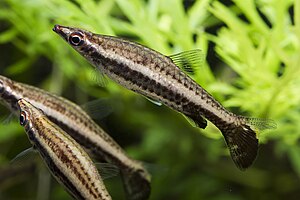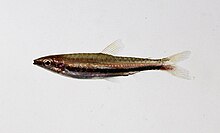Ornamental tetra
| Ornamental tetra | ||||||||||||
|---|---|---|---|---|---|---|---|---|---|---|---|---|

Black tetra ( Nannostomus eques ) |
||||||||||||
| Systematics | ||||||||||||
|
||||||||||||
| Scientific name | ||||||||||||
| Nannostomus | ||||||||||||
| Günther , 1872 |
The pencilfish ( Nannostomus ) are a genus of fish from tropical South America , in the tribe Nannostomini the family of Sicklefishes belongs (Lebiasinidae). The genus currently comprises 19 species described .
Ornamental tetra are relatively small, socially living fish of which many species are popular aquarium fish due to their small size and high-contrast coloring . The German common name also comes from the aquarium hobby , while the peculiarity of a very small mouth is reflected in the scientific naming ( Latin nannus "small", Greek stoma "mouth"). In English-speaking countries, the ornamental tetra are aptly referred to as pencilfishes because of their pencil-like appearance .
features

Ornamental tetra have a slim, elongated body with a rounded, laterally hardly flattened cross-section. Their snout length is short, their mouth small, narrow and terminal . The standard length of adults is only 1.6 to 6.5 cm, depending on the species.
The dentition of the genus Nannostomus shows the following characteristics, in contrast to other genera of the family Lebiasinidae: the intermaxillary bone and lower jaw are covered with a row of multi-pointed incisors, while there is an additional second row of small, conical teeth in the lower jaw. In addition, the tetras lack the forehead fontanel . Some species have an adipose fin , others lack it. This difference can also exist within the same species.
Each species has an individual pattern that is based on one, two or three dark vertical stripes: a primary stripe in the middle of the body, a secondary stripe in the back and a tertiary stripe in the abdominal region. The daytime coloration differs significantly from the nighttime coloration (camouflage coloration) in almost all species. The high-contrast vertical stripes disappear almost completely and are replaced by a pattern of spots or cross bands.
distribution
Ornamental tetra occur in the catchment areas of large streams and rivers of tropical South America , such as the Amazon , Rio Negro and the upper Orinoco . The distribution area includes the states of Brazil , Venezuela , Colombia , Suriname , Guyana , French Guiana , Peru and Bolivia . The tie-in ornamental tetra ( Nannostomus unifasciatus ) is a neozoon in Trinidad and Tobago .
Way of life
Ornamental tetra are calm, slow swimmers and relatively shy animals. During the day they prefer to stand between roots and plants in the upper and middle water regions and only become active and search for food in the cover of dusk. They mainly feed on the smallest insects that fall on the surface of the water, and on growth (algae and the microorganisms they contain). Even if ornamental tetra are not schooling fish , they live in large social associations. They always seek visual contact with their fellow species, but at the same time keep them at an individual distance with the help of threatening gestures and pseudo attacks.
Ornamental tetra biotopes in larger rivers are usually the low-current, shallow bank zones and bays with dense populations of aquatic plants and the surface of which is partially covered with floating plants or floating leaves of submerged plants, as well as smaller, weedy or shaded rivers with low currents. Most of them are black water rivers , more rarely clear water rivers or mixed forms of black and clear water. Almost without exception, water hardness and conductivity are extremely low and show a very acidic reaction ( pH values below 4). The water temperature is usually around 24 ° C, but can occasionally rise to over 30 ° C.
Systematics
M. Weitzman & SH Weitzman assigned 16 species to the genus Nannostomus in 2003 . In 2009, 2011 and 2013 three more species were described by A. Zarske . Other still undescribed species are known.
The preferably obliquely floating nannostomus eques ( Nannostomus eques ) and inclusion-pencilfish ( Nannostomus unifasciatus ) were previously in the genus Nannobrycon performed.
- Nannostomus anduzei Fernandez & Weitzman, 1987
- Ribbed tetra ( Nannostomus beckfordi ) Günther, 1872
- Two-band ornamental tetra ( Nannostomus bifasciatus ) Hoedeman, 1954
- Nannostomus britskii Weitzman, 1978
- Two- striped ornamental tetra ( Nannostomus digrammus ) (Fowler, 1913)
- Black tetra ( Nannostomus eques ) Steindachner, 1876
- Espes ornamental tetra ( Nannostomus espei ) (Meinken, 1956)
- Nannostomus grandis Zarske, 2011
- Gold-banded ornamental tetra ( Nannostomus harrisoni ) (Eigenmann, 1909)
- Nannostomus limatus Weitzman, 1978
- Dwarf ornamental tetra ( Nannostomus marginatus ) Eigenmann, 1909
- Marylin's ornamental tetra ( Nannostomus marilynae ) Weitzman & Cobb, 1975
- Small ornamental tetra ( Nannostomus minimus ) Eigenmann, 1909
- Purple tetra ( Nannostomus mortenthaleri ) Paepke & Arendt, 2001
- Ornamental tetra ( Nannostomus nitidus ) Weitzman, 1978
- Nannostomus nigrotaeniatus Zarske, 2013
- Nannostomus rubrocaudatus Zarske, 2009
- Three-banded ornamental tetra ( Nannostomus trifasciatus ) Steindachner, 1876
- Tie-in ornamental tetra ( Nannostomus unifasciatus ) Steindachner, 1876
swell
literature
- Wolfgang Staeck: Tetra from South America. Verlag Dähne, 2008, ISBN 978-3-935175-41-8 .
- Günther Sterba : The world's freshwater fish. 2nd Edition. Urania, Leipzig / Jena / Berlin 1990, ISBN 3-332-00109-4 .
- Hans A. Baensch : Aquarien Atlas 1. Verlag Mergus, 2006, ISBN 3-88244-227-1 .
- M. Weitzman, SH Weitzman: Family Lebiasinidae (Pencil Fishes). In: RE Reis, SO Kullander, CJ Ferraris Jr. (Eds.): Check List of the Freshwater Fishes of South and Central America. Edipucrs Verlag, 2003, ISBN 85-7430-361-5 . (English)
Individual evidence
- ↑ a b c d M. Weitzman, SH Weitzman: Family Lebiasinidae (Pencil Fishes). In: RE Reis, SO Kullander, CJ Ferraris Jr. (Eds.): Check List of the Freshwater Fishes of South and Central America. Edipucrs Verlag, 2003, ISBN 85-7430-361-5 , pp. 241, 243-246.
- ↑ a b c A. Zarske: Nannostomus grandis spec. nov. - a new ornamental tetra from Brazil with comments on N. beckfordi GÜNTHER, 1872, N. anomalus STEINDACHNER, 1876 and N. aripirangensis MEINKEN, 193 (Teleostei: Characiformes: Lebiasinidae). (PDF; 1.5 MB). In: Vertebrate Zoology. 61 (3), 2011, pp. 283-297.
- ↑ a b c A. Zarske: Nannostomus rubrocaudatus sp. n. - a new ornamental tetra from Peru (Teleostei: Characiformes: Lebiasinidae). (PDF; 1.2 MB). In: Vertebrate Zoology. 59 (1), 2009, pp. 11-23.
- ↑ a b c A. Zarske: Nannostomus nigrotaeniatus spec. nov. - a new ornamental tetra from Venezuela (Teleostei: Characiformes: Lebiasinidae). In: Vertebrate Zoology. 63, (2), pp. 125-137. (PDF)
Web links
- Nannostomus on Fishbase.org (English)

